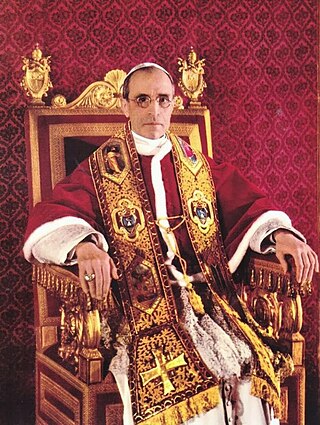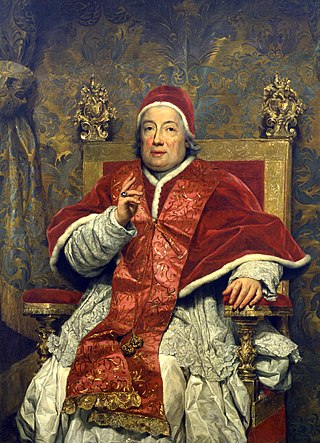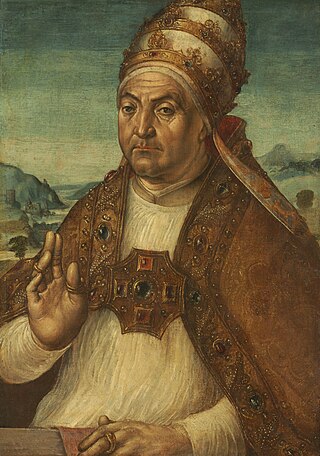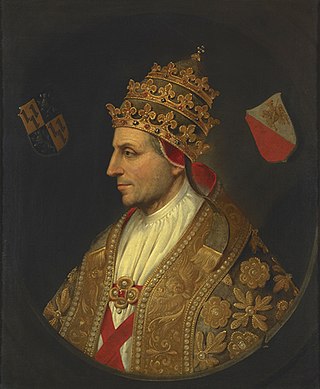Description
When the votes of the cardinals in the first ballot have been counted, and no candidate has achieved a two-thirds majority, at the following vote opportunity is granted for a cardinal to change his vote, by writing "Accedo domino Cardinali ...", mentioning one of those who have been voted for, but not the cardinal for whom he has already voted. If he should not wish to change his vote, the cardinal can vote "Nemini" ("for no one"). If these supplementary votes of accession, added to those a candidate has received, equal two-thirds of the total vote, then there is an election. If not, the ballots are burned, and the usual ballot takes place the next day.
Election by accessus was only possible because, until the mid-20th century, the ballots used by each cardinal were identified by a text of scripture in the back side. When a cardinal decided to use the right of accession, his two ballots had to "be compared and identified by the text on the reverse face of the ballot, so as to prevent a double vote for the same candidate by any elector". [3]
Thus, voting by accession eliminated the secrecy of the first ballot.
Voting by accessus was prohibited by the Cardinal Dean at the 1903 conclave and later this form of election was suppressed from the Catholic Church's legislation.
Universi Dominici gregis is an apostolic constitution of the Catholic Church issued by Pope John Paul II on 22 February 1996. It superseded Pope Paul VI's 1975 apostolic constitution, Romano Pontifici eligendo, and all previous apostolic constitutions and orders on the subject of the election of the Roman Pontiff.

A papal conclave is a gathering of the College of Cardinals convened to elect a bishop of Rome, also known as the pope. Catholics consider the pope to be the apostolic successor of Saint Peter and the earthly head of the Catholic Church.

A papal conclave was held on 18 and 19 April 2005 to elect a successor to John Paul II, who had died on 2 April 2005. Upon the pope's death, the cardinals of the Catholic Church who were in Rome met and set a date for the beginning of the conclave. Of the 117 eligible members of the College of Cardinals, those younger than 80 years of age at the time of the death of Pope John Paul II, all but two attended. After several days of private meetings attended by both cardinal electors and non-voting cardinals, the conclave began on 18 April 2005. It ended the following day after four ballots with the election of Cardinal Joseph Ratzinger, Dean of the College of Cardinals and Prefect of the Congregation for the Doctrine of the Faith. After accepting his election, he took the name Benedict XVI.

The papal conclave held from 31 July to 4 August 1903 saw the election of Cardinal Giuseppe Melchiorre Sarto to become pope in succession to Leo XIII, who had died on 20 July after a 25-year-long pontificate. Some 62 cardinals participated in the balloting. Emperor Franz Joseph of Austria asserted the right claimed by certain Catholic rulers to veto a candidate for the papacy, blocking the election of the leading candidate, Cardinal Secretary of State Mariano Rampolla. Sarto was elected on the seventh ballot and took the name Pius X.

The papal conclave held from 14 to 16 October 1978 was triggered by the death of John Paul I on 28 September 1978, just 33 days after he was elected pope. The conclave to elect John Paul I's successor ended after eight ballots. The cardinal electors selected Cardinal Karol Józef Wojtyła, Archbishop of Kraków, as the new pope. The third pope in the year, Wojtyła accepted his election and took the name John Paul II.

In the papal conclave held from 14 to 16 June 1846, Giovanni Maria Mastai Ferretti was elected to succeed the recently deceased Gregory XVI as pope. He took the name Pius IX and had the longest pontificate since Saint Peter.

The papal conclave held on 1 and 2 March 1939 saw Cardinal Eugenio Pacelli elected on the third ballot to succeed Pius XI, who had died on 10 February, as pope. All 62 cardinals took part. Pacelli, who had been camerlengo and secretary of state, took the name Pius XII. The day was his 63rd birthday.

The 1492 papal conclave was convened after the death of Pope Innocent VIII. It was the first papal conclave to be held in the Sistine Chapel.

The 1758 papal conclave, convoked after the death of Pope Benedict XIV, elected Cardinal Carlo Rezzonico of Venice, who took the name Clement XIII.

The 1721 papal conclave, convoked after the death of Pope Clement XI, elected Cardinal Michelangelo de' Conti, who took the name of Innocent XIII.

The 1294 papal conclave was convoked in Naples after the resignation of Pope Celestine V on 13 December 1294. Celestine V had only months earlier restored the election procedures set forth in the papal bull Ubi periculum of Pope Gregory X, which had been suspended by Pope Adrian V in July 1276. Every papal election since then has been a papal conclave. It was the first papal conclave held during the lifetime of the preceding pontiff, an event not repeated until the 2013 papal conclave following the resignation of Pope Benedict XVI.

The 1458 papal conclave, convened after the death of Pope Callixtus III, elected as his successor Cardinal Enea Silvio Piccolomini who took the name Pius II.

The 1455 papal conclave elected Cardinal Alfons Borja Pope Callixtus III following the death of Pope Nicholas V. The conclave was the first in the Apostolic Palace, the site of all but five papal conclaves thereafter. The conclave was also the first to feature accessus voting, derived from a practice of the Roman Senate, where a cardinal could change their vote after an unsuccessful scrutiny to any cardinal already receiving votes.

The 1471 papal conclave elected Pope Sixtus IV following the death of Pope Paul II. With the exception of the conclaves of the Western Schism, this conclave was the first since 1305 to feature a working, two-thirds majority of Italians within the College of Cardinals, in no small part because of the absence of six non-Italian cardinals. This was in part due to the unexpectedness of the death of Paul II.
Ubi periculum is a papal bull promulgated by Pope Gregory X during the Second Council of Lyon on 7 July 1274 that established the papal conclave format as the method for selecting a pope, specifically the confinement and isolation of the cardinals in conditions designed to speed them to reach a broad consensus. Its title, as is traditional for such documents, is taken from the opening words of the original Latin text, Ubi periculum maius intenditur, 'Where greater danger lies'. Its adoption was supported by the hundreds of bishops at that council over the objections of the cardinals. The regulations were formulated in response to the tactics used against the cardinals by the magistrates of Viterbo during the protracted papal election of 1268–1271, which took almost three years to elect Gregory X. In requiring that the cardinals meet in isolation, Gregory was not innovating but implementing a practice that the cardinals had either adopted on their own initiative or had forced upon them by civil authorities. After later popes suspended the rules of Ubi periculum and several were elected in traditional elections rather than conclaves, Pope Boniface VIII incorporated Ubi periculum into canon law in 1298.
Prospero Colonna was a cardinal-nephew of Pope Martin V, whose election ended the Western Schism. Colonna was excommunicated for a period due to his rebellion against Martin V's successor, Pope Eugene IV, becoming one of the few excommunicated cardinals. Despite this, Colonna was the leading candidate to succeed Eugene IV in the papal conclave, 1447, where he was two votes away from election for the first three days.

The 1521–22 papal conclave elected Pope Adrian VI to succeed Pope Leo X. The conclave was marked by the early candidacies of cardinal-nephew Giulio de'Medici and Alessandro Farnese, although the Colonna and other cardinals blocked their election.

In the papal conclave held from 8 to 16 May 1605 Cardinal Camillo Borghes was elected to succeed Leo XI as pope. Borghes took the name Paul V. This was the second conclave of 1605, with the one that had elected Leo XI having concluded just 37 days earlier. It is significant for having the only recorded case of an injury at a papal conclave, which was the result of a physical fight amongst the cardinals over who should be elected pope.
In the course of his papacy, Benedict XVI issued two documents altering certain details of the procedures for electing a pope: De electione romani pontificis on 11 June 2007 and Normas nonnullas on 22 February 2013. These instructions amended the extensive set of rules and procedures issued on 22 February 1996 by his predecessor John Paul II in his apostolic constitution Universi Dominici gregis.
Aeterni Patris Filius, also called Aeterni Patris, was a bull issued by Pope Gregory XV on 15 November 1621 that regulated papal conclaves. Together with the bull Decet Romanum pontificem of 1622, it formed the canonical basis for papal elections until the 20th century. The bull brought about many reforms to the papal election system, created structured rules, and sought to decrease the influence of organized factions within the College of Cardinals during the conclave as well as decrease the influence of secular monarchs on papal elections. It established general rules for the conclave process, while the later bull Decet Romanum pontificem addressed the ceremonial aspects of papal elections.
![]() This article incorporates text from a publication now in the public domain : Herbermann, Charles, ed. (1913). "Accessus". Catholic Encyclopedia . New York: Robert Appleton Company.
This article incorporates text from a publication now in the public domain : Herbermann, Charles, ed. (1913). "Accessus". Catholic Encyclopedia . New York: Robert Appleton Company.













